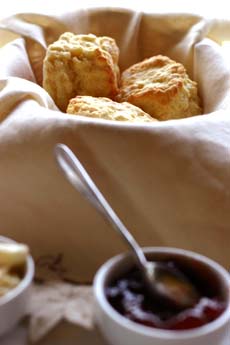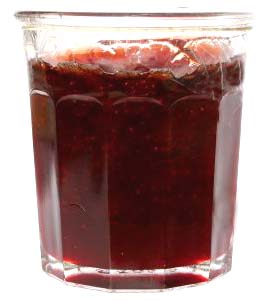

When it’s time to reach for the jam, reach for the best. We nibbled our way through dozens of artisan-made jams to find them for you. Photo by N. Joy Neish.
|
STEPHANIE ZONIS is a contributing editor.
|
|
June 2006
Updated December 2008
|
 |
The Best Strawberry Jams & Preserves
Page 3: The Sugar Level In Jam
This is Page 3 of a seven-page article. Click on the black links below to visit other pages.
About The Sugar Level In Jam (Saints Preserve Us!)
One of the distinguishing characteristics of American society is the existence of a dietary villain or two at any given time. These villains change after a month or a year, but as things stand now, refined sugar is one of the new bad guys in town. Should you be eating preserves or jam at all? What about corn syrup or HFCS (high fructose corn syrup) as a sweetener? Why not switch to preserves sweetened only with concentrated fruit juice?
It’s already been noted that sugar is an important component of many preserves. Most healthy people can consume refined sugars (or any other type) within reason. Some jam manufacturers use corn syrup, or HFCS in their products; the chief virtue of the two seems to be that they are less expensive than sugar. In addition, there is some evidence linking consumption of HFCS to increased caloric consumption and weight gain, although much of that evidence has been derived from soft drink consumption. Of more importance for the scope of this article is the fact that the use of corn syrup, particularly HFCS, leads to a syrupy sweetness and sticky texture in a jam or preserve. Using either or both will allow a manufacturer to produce a jam or preserve at less cost, and therefore one that can be sold at a lower price. However, the jam/preserve thus produced will almost certainly be excessively sweet and of lesser quality. Fortunately, most of these preserves are of the grocery store variety and can easily be avoided.

Jams, jellies and preserves are made with
sugar: you can taste the strawberries. If
products are sweetened with fruit juice
concentrate, generally grape or pear juice, the strawberry taste is subdued by those flavors. Photo by Gaston Thauvin.
|
The amount of sugar in a jam or preserve (as well as in some other products, such as wine) is measured in degrees Brix, abbreviated as “dB” and commonly called a “Brix reading” or “Brix number.” Simply put, degrees Brix is a measure of the ratio of dissolved sucrose in a water-based food system. It’s measured with an instrument called a “saccharimeter.” (Technically, a refractometer, also often used for measuring dB, will give you information on total dissolved solids, not just sucrose.) Typical jams and preserves have a Brix number that ranges from the 40s into the 60s, indicating a substantial percentage of sugar. So why not switch to a fruit spread, one sweetened with fruit juice concentrate or fruit syrup? Why bother to factor sugar into the equation at all? |
Allyn Johnston of Mountain Fruit Company answers this question perfectly and succinctly by asking, “What are you buying?” Much of the fruit juice concentrate used to sweeten products is from pears or grapes. Both are chosen for several factors, especially their cost; they’re relatively inexpensive. They need to be, because concentrated juice isn’t as sweet as sugar, so you’ll need plenty of it to sweeten your fruit spread. The question should come down to how much fruit is in your jam or preserve versus how much sweetening it contains. In a jam or preserve sweetened with fruit juice concentrate or fruit syrup, you won’t have refined sugar, but you’ll have plenty of other sugar, albeit of a different type. Again, what are you buying? If you’re going to buy strawberry jam or preserves, don’t you want to be paying for a product that’s mostly fresh strawberries, not white grape juice concentrate or pear juice concentrate? Hopefully, you also want a product that tastes like strawberries. Fruit spreads sweetened with grape juice or pear juice concentrate often have their strawberry taste overwhelmed, or at least greatly subdued, by these concentrates.
A further note about the use of fruit in jams and preserves: Some companies use dried fruits in their preserves. Although this seems to be less of a problem in strawberry jam than in, for instance, apricot, companies are not legally required to tell you if they’re using dried fruit, unless the fruit contains sulfites. If you see a jam jar label with a warning that the jam within contains or may contain sulfites, it’s a good indication that at least some dried fruit has gone into the mix. Dried fruit has several advantages over fresh fruit, including shelf life and the fact that it’s invariably sweeter than fresh fruit, which can cut down on the amount of sweetener a manufacturer needs to add to its product.
Continue To Page 4: What To Look For In A Jam
Go To The Article Index Above

|



